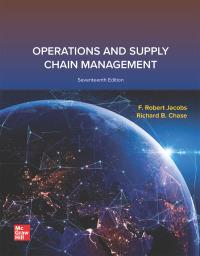Answer the following questions. Answers are listed at the end of this section. 1. The queuing models
Question:
Answer the following questions. Answers are listed at the end of this section.
1. The queuing models assume that customers are served in what order?
2. Consider two identical queuing systems except for the service time distribution. In the first system, the service time is random and Poisson distributed. The service time is constant in the second system. How would the waiting time differ in the two systems?
3. What is the average utilization of the servers in a system that has three servers? On average, 15 customers arrive every 15 minutes. It takes a server exactly three minutes to wait on each customer.
4. What is the expected waiting time for the system described in question 3?
5. Firms that desire high service levels where customers have short wait times should target server utilization levels at no more than this percentage.
6. In most cases, if a firm increases its service capacity by 10 percent, it would expect waiting times to be reduced by what percentage? Assume customer arrivals and service times are random.
7. An ice cream stand has a single window and one employee to serve customers. During their busy season, 30 customers arrive each hour, on average. It takes 1.5 minutes, on average, to serve a customer.
What is the utilization of the employee?
8. How long would customers have to wait in line, on average, at the ice cream shop discussed in question 7?
9. Random service times can be modeled by this.
10. A bank teller takes 2.4 minutes, on average, to serve a customer. What would be the hourly service rate used in the queuing formulas?
11. There are three teller windows in the bank described in the prior question. On average, 60 customers per hour arrive at the bank. What will be the average number of customers in line at the bank?
Step by Step Answer:

Operations And Supply Chain Management
ISBN: 9781265071271
17th Edition
Authors: F. Robert Jacobs, Richard Chase





